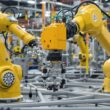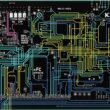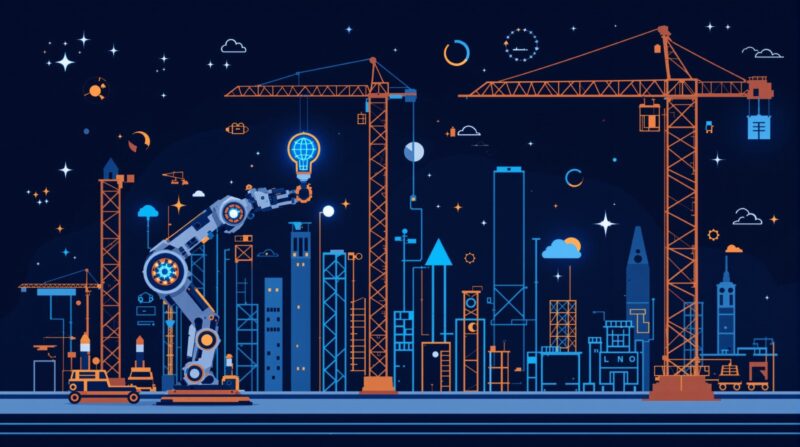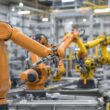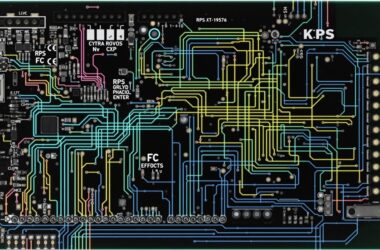Robotics in construction is radically reshaping the building industry with autonomous systems that address critical issues like labor shortages, safety, and sustainability in unprecedented ways. The global market for construction robots is expanding rapidly, with projections showing growth from $5.5 billion in 2024 to nearly $13 billion by 2029 as companies increasingly adopt these technologies to overcome persistent industry challenges.
Key Takeaways
- The construction robotics market is projected to grow at an 18.7% CAGR through 2029, reaching $12.99 billion
- Robotic systems reduce material waste by 30% and cut on-site accidents by 40%
- Collaborative robots perform bricklaying three times faster than human workers
- AI-powered construction robots can reduce project timelines by 15-20% through increased efficiency
- Initial investments of $10,000-$50,000 per robot typically yield 200% ROI over five years
Revolutionizing Construction: How Robotics are Transforming the Building Industry
The robotics in construction industry is experiencing a revolution that’s changing how we build. With $5.5 billion in market value for 2024 and projections to reach $12.99 billion by 2029, automated construction solutions are becoming central to modern building practices. This remarkable 18.7% compound annual growth rate highlights how quickly the sector is evolving.
Labor shortages represent one of the primary drivers behind this growth. With a documented 7,000-worker deficit in the U.S. construction sector alone, robots are filling crucial gaps by handling repetitive, dangerous, and physically demanding tasks. This shift allows human workers to focus on more complex aspects of construction that require judgment and creativity.
The applications of robotics technology in construction extend far beyond simply replacing human labor. These systems are creating safer workplaces with a 40% reduction in on-site accidents through the use of remote-controlled demolition robots and autonomous equipment that can operate in hazardous environments.

Market Growth and Economic Benefits
The financial implications of construction robotics are substantial. With the market expected to grow from $6.55 billion in 2025 to $12.99 billion by 2029, companies are rapidly adopting these technologies to gain competitive advantages. The economic benefits extend beyond simple efficiency gains.
Initial investments typically range from $10,000 to $50,000 per robot, a price point that might seem steep at first glance. However, the return on investment is compelling, with many firms reporting a 200% ROI over a five-year period. These returns come from multiple sources including reduced labor costs, decreased material waste, and shorter project timelines.
Companies like ABB Robotics are leading research and development for autonomous excavators and demolition systems that further enhance these economic benefits. Their innovations are helping to address the Australian residential construction boom, which is seeing 14.6% annual growth in new houses and creating significant demand for automated building solutions.
Labor Shortages and Efficiency Solutions
The construction industry faces a persistent workforce gap that’s expected to widen in coming years. Current estimates show a 7,000-worker deficit in the U.S. construction sector alone. This shortage is driving companies to seek automated alternatives that can maintain or increase productivity with fewer human workers.
Collaborative robots, commonly known as “cobots,” represent one of the most promising solutions to this challenge. These machines can perform bricklaying operations three times faster than human workers while maintaining consistent quality. This dramatic efficiency increase helps construction companies meet tight deadlines despite workforce limitations.
The impact on project timelines is substantial, with robotics implementation typically reducing overall construction schedules by 15-20%. This improvement addresses the growing need for rapid urban development, as projections indicate we’ll need to build 13,000 new buildings daily by 2050 to accommodate global urbanization.
The changing labor landscape doesn’t mean humans are being eliminated from construction sites. Rather, robots are handling approximately 40% of repetitive tasks, which frees human workers to focus on design, problem-solving, and oversight roles that require judgment and creativity. However, this shift requires new skills, and currently, 45% of construction workers lack the training needed for robotic oversight.
Revolutionary Technological Innovations
The latest trends in robotics are creating remarkable capabilities for the construction industry. Boston Dynamics’ Spot robot exemplifies this innovation by navigating construction sites to collect real-time LiDAR data, improving tracking accuracy by an impressive 90%. This quadruped robot can traverse terrain that would be difficult for wheeled vehicles, allowing it to monitor progress throughout complex building sites.
Autonomous Mobile Robots (AMRs) are reducing the need for manual site inspections by 50%, which significantly cuts labor costs while increasing the frequency and consistency of monitoring. This technology ensures potential issues are identified early, preventing costly corrections later in the project lifecycle.
Additive manufacturing, particularly 3D printing technology, is perhaps the most transformative innovation. Robotic 3D printers can now construct concrete walls in just 8 hours compared to the 3 days required for manual methods. These systems also use 15-20% less material through precision extrusion, contributing to both cost savings and sustainability goals.
The integration of AI algorithms with construction robots creates systems that can analyze sensor data to predict structural weaknesses, reducing rework by 30%. Software solutions like Autodesk’s Dynamo automate analytical modeling for code-compliant designs, ensuring buildings meet local regulations while optimizing material usage and structural integrity.
Safety and Sustainability Advancements
Construction sites traditionally rank among the most dangerous workplaces, but robotics is changing this reality. Remote-controlled demolition robots are decreasing injury rates by 40% by removing humans from hazardous environments. These specialized machines can outperform 22 human workers in debris removal at demolition sites while eliminating risk to personnel.
The sustainability impact is equally significant. AI-optimized material usage is cutting waste by 25-30%, directly lowering the carbon footprint of construction projects. 3D printing techniques further enhance sustainability by using precisely the amount of material needed with no excess.
Brokk’s remote-controlled robots exemplify these benefits through their performance in hazardous environment remediation. At the Fukushima cleanup site, these robots reduced debris removal time by 50% while protecting human workers from radiation exposure. This demonstrated how robotics can make previously impossible or extremely dangerous tasks both feasible and safe.
The concept of circular construction is gaining momentum with robots achieving 95% recycling rates for material reuse. These systems can carefully disassemble structures rather than demolishing them, preserving valuable building materials for future projects and dramatically reducing waste.
Case Studies: Robotics in Action
Real-world implementations provide compelling evidence of robotics’ transformative impact on construction. Apis Cor’s robotic systems successfully built a 600-square-foot concrete house in just 24 hours—a task that would typically take weeks using conventional methods. This achievement demonstrates both the speed and precision of modern construction robots.
Autodesk’s Robot Structural Analysis software represents the digital side of this revolution by ensuring code compliance across 150+ countries. This technology integrates with Building Information Modeling (BIM) systems for real-time updates, allowing engineers to rapidly test and modify designs before physical construction begins.
The technology is becoming more accessible, with entry-level monitoring robots starting at $5,000, while advanced systems may exceed $75,000. Despite these costs, the rapid return on investment makes them viable for companies of various sizes. The integration of these robots with IoT devices and digital twins further enhances their value by creating comprehensive construction management systems.
These case studies highlight how AI-powered robotics is transforming the construction industry from design through completion, resulting in buildings that are constructed faster, with greater precision, and at lower cost than traditional methods could achieve.
Challenges to Widespread Adoption
Despite the clear benefits, several obstacles slow the integration of robotics in construction. Financial barriers represent a significant challenge, particularly for small firms facing hefty upfront investments for cobots priced between $25,000 and $100,000. Additionally, maintenance and software updates add 10-15% annually to operational costs, creating ongoing financial considerations.
Regulatory hurdles further complicate adoption. Varying international building codes make it difficult to program robots for compliance across different jurisdictions. This regulatory fragmentation typically delays deployments by 6-12 months as systems are adapted to meet local requirements.
Workforce acceptance remains a persistent issue. Many construction professionals express concerns about job displacement, creating resistance to implementing robotic systems. This challenge is compounded by a lack of standardized training and certification programs for workers who will oversee and maintain these advanced systems.
Technical limitations also persist. Current robotics technology excels at repetitive, predictable tasks but struggles with the highly variable conditions of construction sites. Weather conditions, unexpected obstacles, and the need to coordinate with human workers all present challenges that require ongoing technological refinement.
Future Outlook: 2025 and Beyond
The future of construction robotics looks remarkably promising. By 2025, autonomous excavators are expected to handle 30% of earthmoving tasks, dramatically reducing the need for human operators in these potentially dangerous operations. These systems will combine AI, computer vision, and precision control to execute complex excavation with minimal supervision.
Swarm robotics represents another frontier, with teams of coordinated robots projected to cut mapping and surveying time by 70%. These swarms will combine aerial drones for overhead perspectives with ground-based robots for detailed measurements, creating comprehensive site models faster than current methods allow.
The concept of fully autonomous construction sites is moving from science fiction to reality for standardized building types. By 2030, we may see complete automated construction of residential structures with minimal human intervention, particularly for affordable housing projects where speed and cost efficiency are paramount.
Integration of robotics with Internet of Things (IoT) technologies and digital twins will create unprecedented levels of monitoring and control throughout the building lifecycle. These connected systems will predict maintenance needs, optimize energy usage, and potentially allow structures to adapt to changing environmental conditions.
As these technologies mature, evolving regulations will accommodate and standardize robotic construction methods. Industry leaders are already working with regulatory bodies to create frameworks that ensure safety while enabling innovation in this rapidly advancing field.
Sources
thebusinessresearchcompany.com – Construction Robotics Global Market Report
Author



